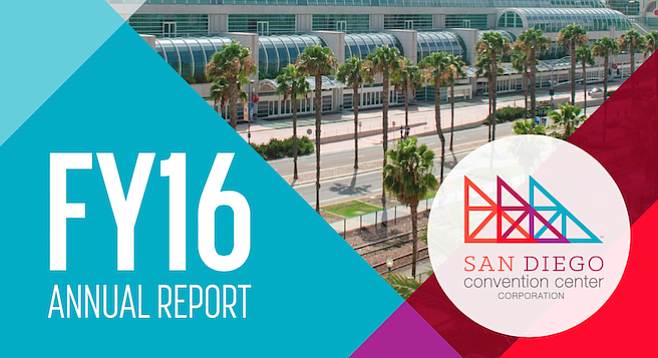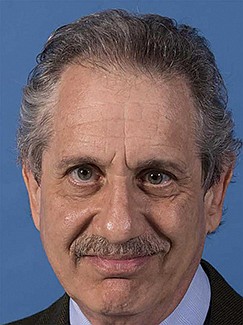 Facebook
Facebook
 X
X
 Instagram
Instagram
 TikTok
TikTok
 Youtube
Youtube

The San Diego Convention Center's 2016 annual report is out, and it raises many questions. For starters, why in the world do cities keep expanding space when only 50 percent of it is in use nationwide and rental prices are being slashed?
In the report, San Diego's center boasts that in the fiscal year 2016, the building was 66 percent occupied — better than the national average of 50 percent. San Diego cut its facility rental prices by 38 percent. So, why are cities racing to add space if centers are half-used?
Seattle, Los Angeles, San Francisco, and Anaheim are in the process of expanding centers or planning to do so.

"It is not plausible that all will succeed or any will succeed," says Heywood Sanders, author of Convention Center Follies, published in 2014, and also author of a seminal study on convention-center overbuilding.
San Diego claims in this year's report that the average stay of attendees is almost four nights.
"People aren't staying anywhere near four nights, and they never have," says Sanders. Many attendees double up and triple up in hotels; many stay with local friends, and many are local. This is especially true with Comic-Con, by far the largest event. Many attendees are brown-baggers and many live in San Diego County or near it.
In this year's report, the Environmental Systems Research Institute (a producer of map software) was counted twice because its conferences were in July of last year and June of this year. Counting the organization's use of the facility twice in one fiscal year inflates money spent on food, hotel-room nights, attendee spending, and overall economic impact of the center in 2016.
The number of events dropped to 158 from 172 in 2015. Nonetheless, attendee spending supposedly went up. But attendee spending and overall economic impact have always been questionable, says Sanders. For example, attendees are said to have spent a total of $44.8 million — $80 per attendee — on retail shopping in the 2016 year. But how can this be measured? Similarly, attendees are said to spend $143 each on food and beverages, for a total of $79.7 million in the latest report. But if the assumption is that attendees spend four days per person, such figures can be grossly inflated, says Sanders.
Says a footnote in the report, "Attendance projections are provided to the [convention center] by the event planner or show manager." These projections can be notoriously high because planners often give inflated numbers to make sure they will have space. Actual attendance often craters, Sanders repeatedly shows, but the numbers often remain the same as in the planner forecast.
"If you net out the extra [Environmental Systems Research Institute] conference, hotel-room nights are doing about as well as in 1998 and 1999," says Sanders. Yet the fervent race to build into a massive national surplus — particularly on the West Coast — goes on.


The San Diego Convention Center's 2016 annual report is out, and it raises many questions. For starters, why in the world do cities keep expanding space when only 50 percent of it is in use nationwide and rental prices are being slashed?
In the report, San Diego's center boasts that in the fiscal year 2016, the building was 66 percent occupied — better than the national average of 50 percent. San Diego cut its facility rental prices by 38 percent. So, why are cities racing to add space if centers are half-used?
Seattle, Los Angeles, San Francisco, and Anaheim are in the process of expanding centers or planning to do so.

"It is not plausible that all will succeed or any will succeed," says Heywood Sanders, author of Convention Center Follies, published in 2014, and also author of a seminal study on convention-center overbuilding.
San Diego claims in this year's report that the average stay of attendees is almost four nights.
"People aren't staying anywhere near four nights, and they never have," says Sanders. Many attendees double up and triple up in hotels; many stay with local friends, and many are local. This is especially true with Comic-Con, by far the largest event. Many attendees are brown-baggers and many live in San Diego County or near it.
In this year's report, the Environmental Systems Research Institute (a producer of map software) was counted twice because its conferences were in July of last year and June of this year. Counting the organization's use of the facility twice in one fiscal year inflates money spent on food, hotel-room nights, attendee spending, and overall economic impact of the center in 2016.
The number of events dropped to 158 from 172 in 2015. Nonetheless, attendee spending supposedly went up. But attendee spending and overall economic impact have always been questionable, says Sanders. For example, attendees are said to have spent a total of $44.8 million — $80 per attendee — on retail shopping in the 2016 year. But how can this be measured? Similarly, attendees are said to spend $143 each on food and beverages, for a total of $79.7 million in the latest report. But if the assumption is that attendees spend four days per person, such figures can be grossly inflated, says Sanders.
Says a footnote in the report, "Attendance projections are provided to the [convention center] by the event planner or show manager." These projections can be notoriously high because planners often give inflated numbers to make sure they will have space. Actual attendance often craters, Sanders repeatedly shows, but the numbers often remain the same as in the planner forecast.
"If you net out the extra [Environmental Systems Research Institute] conference, hotel-room nights are doing about as well as in 1998 and 1999," says Sanders. Yet the fervent race to build into a massive national surplus — particularly on the West Coast — goes on.
Comments